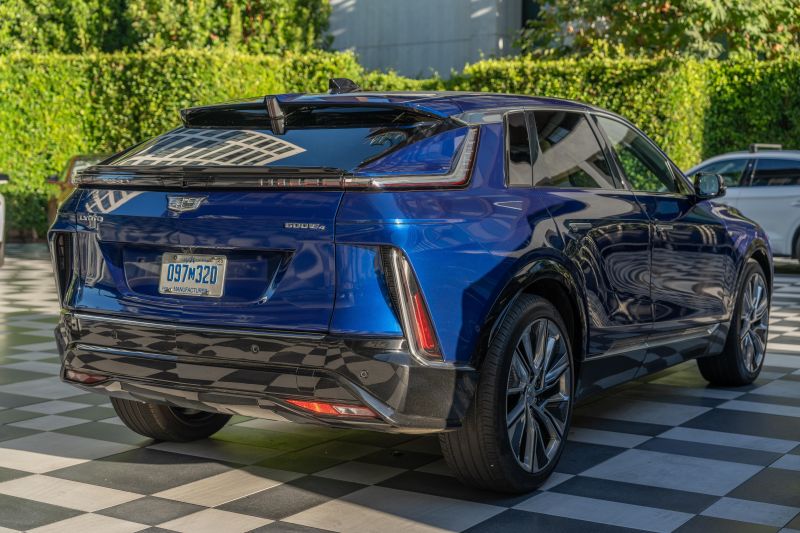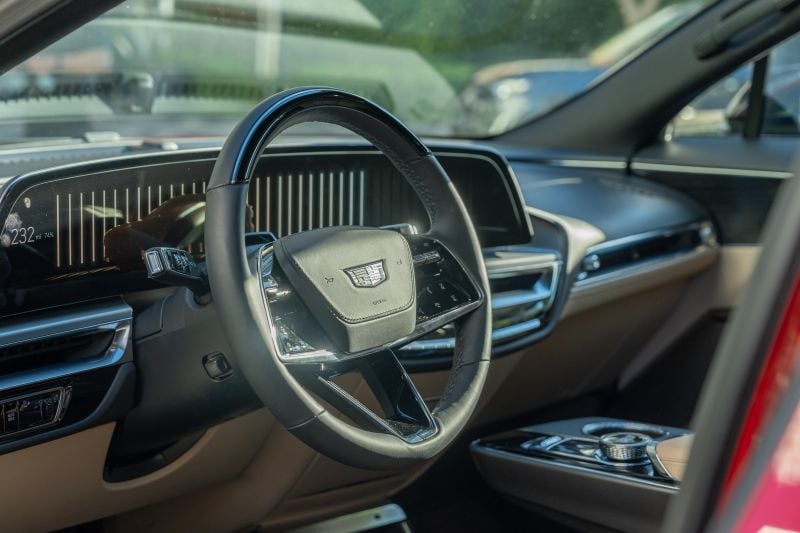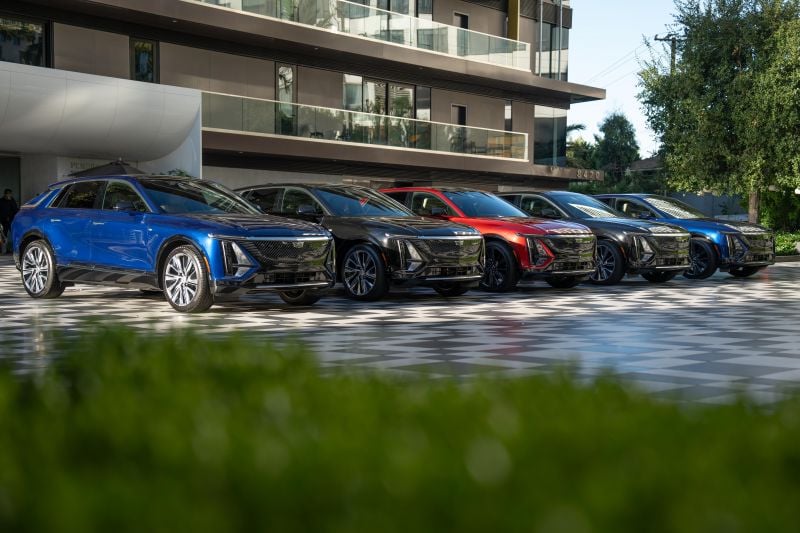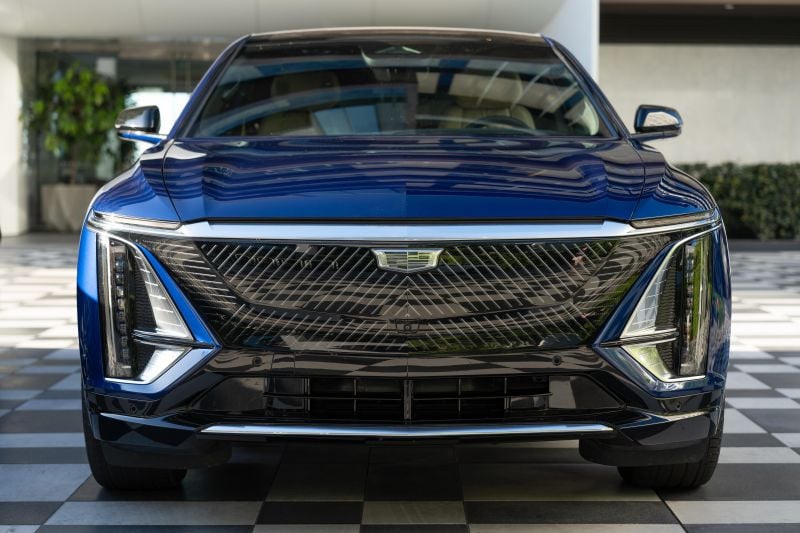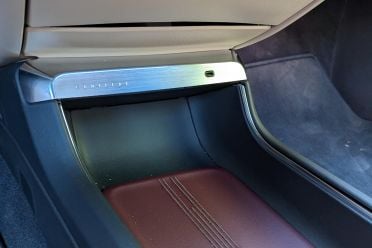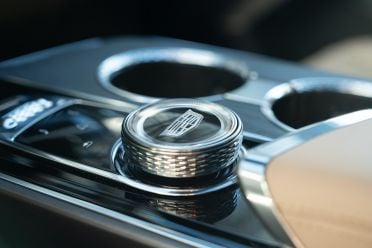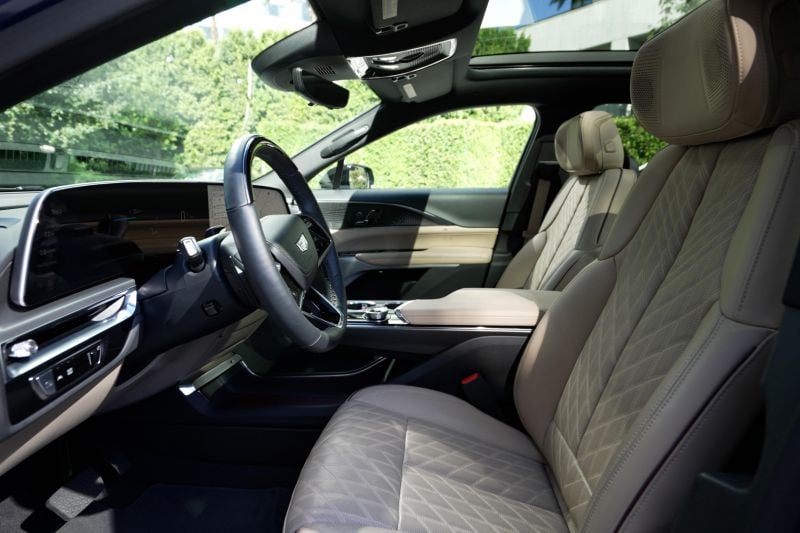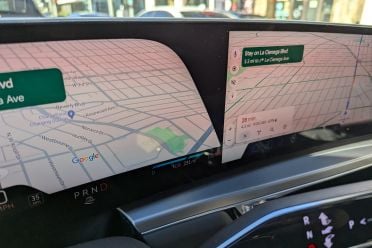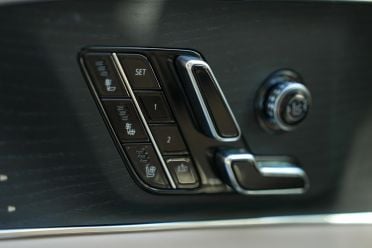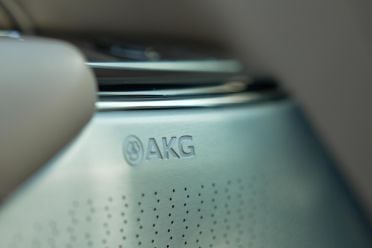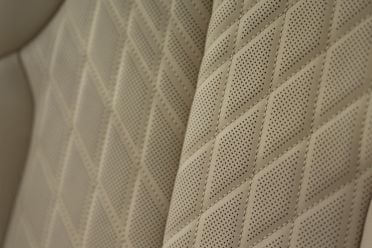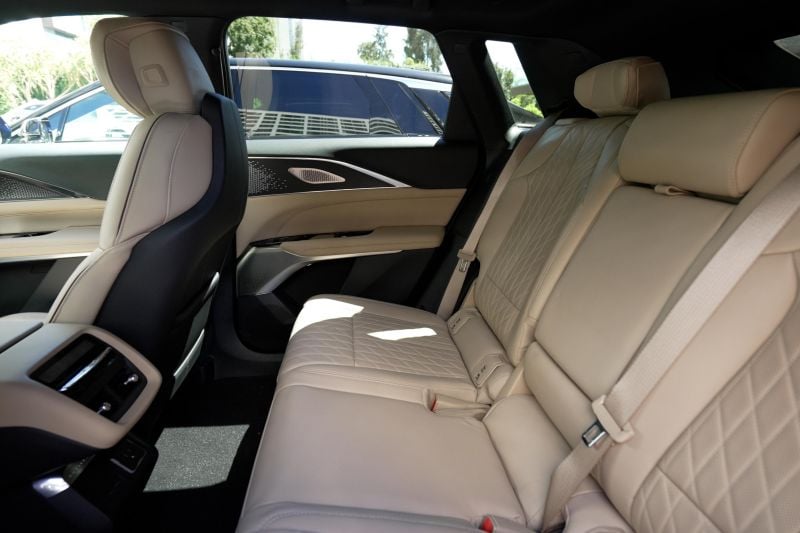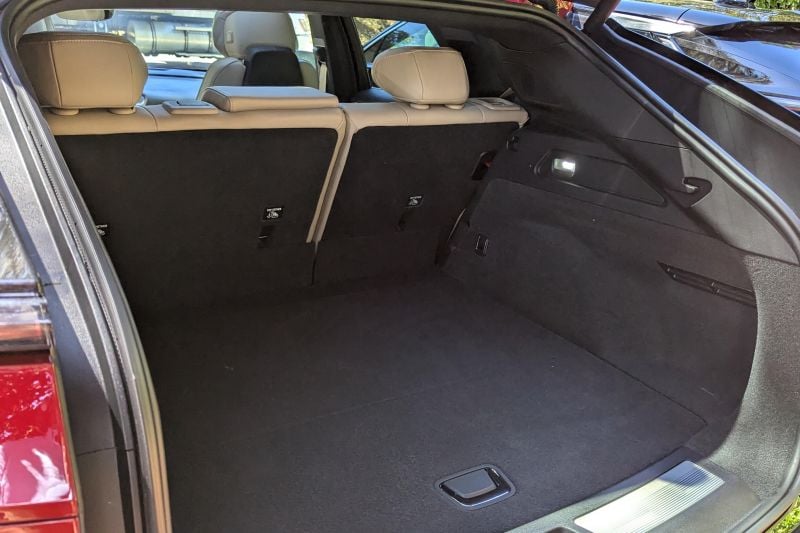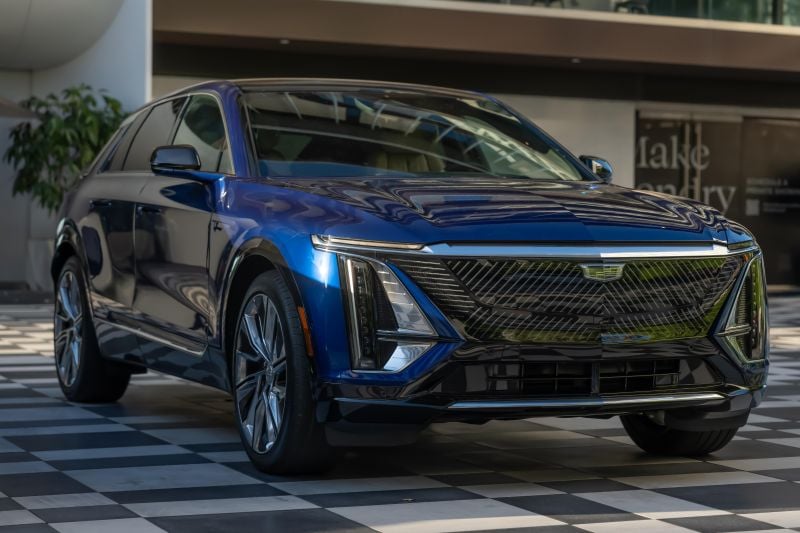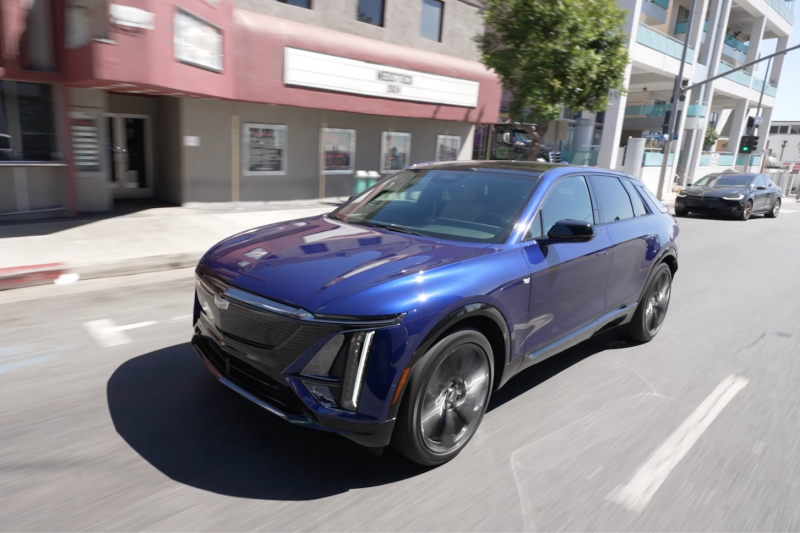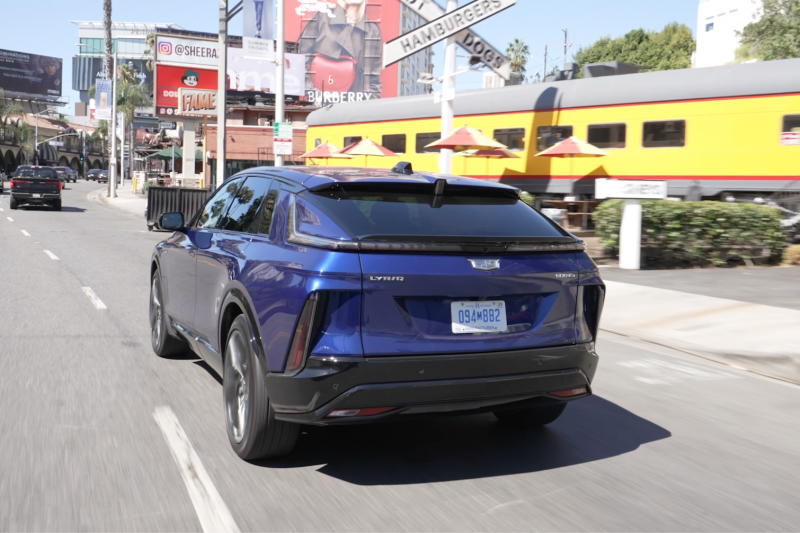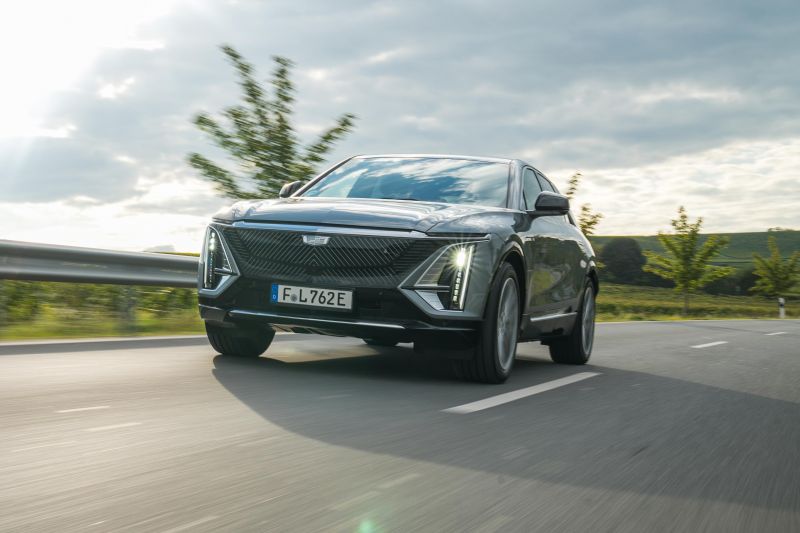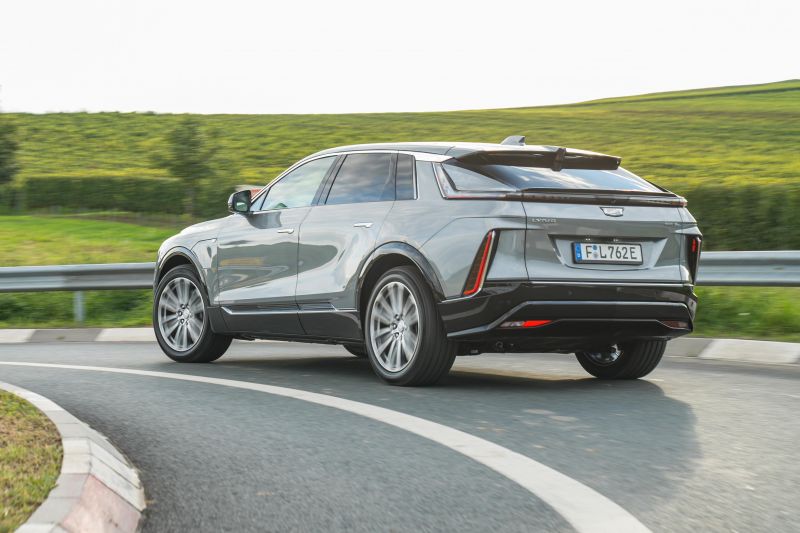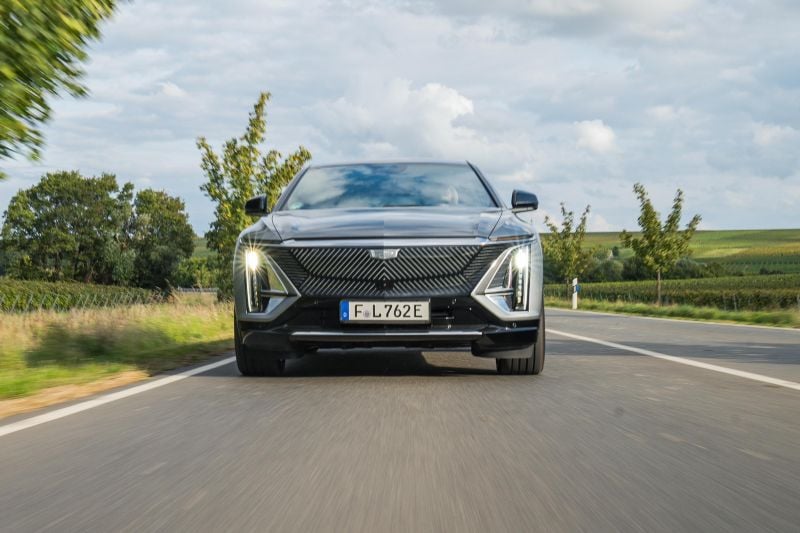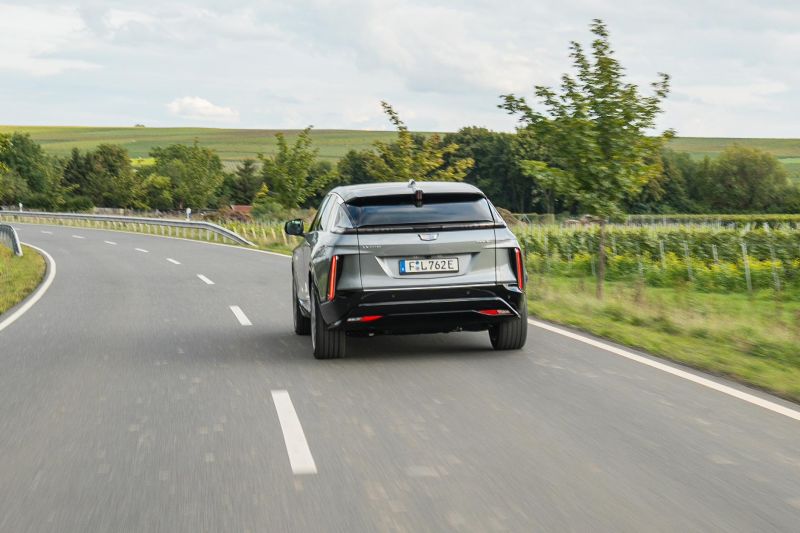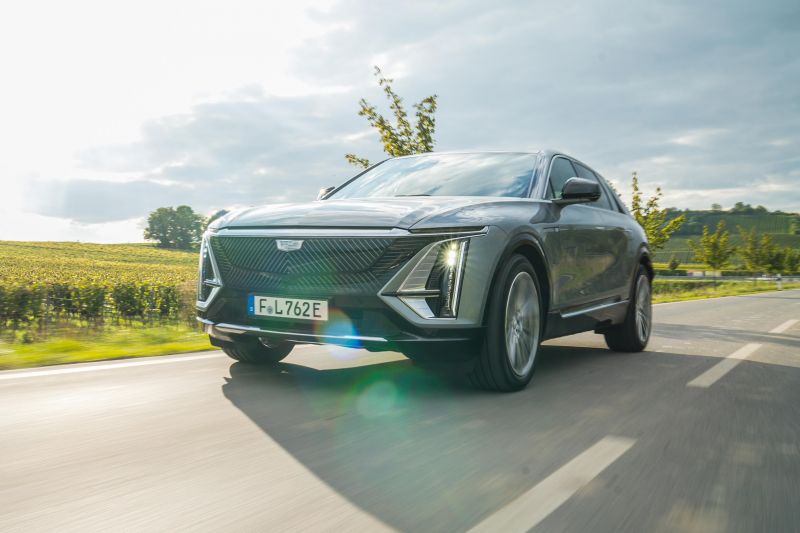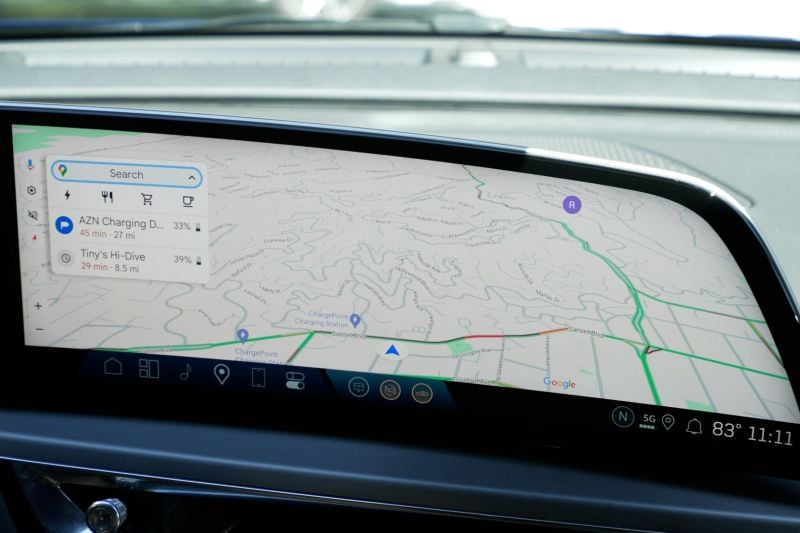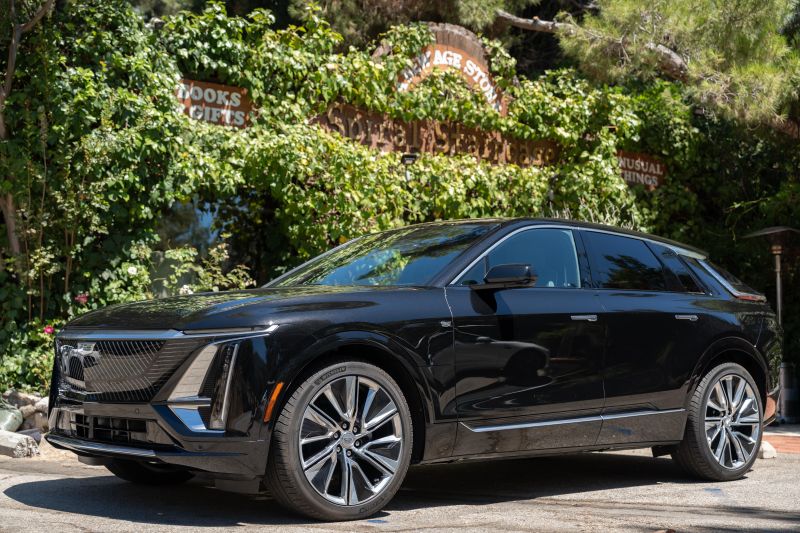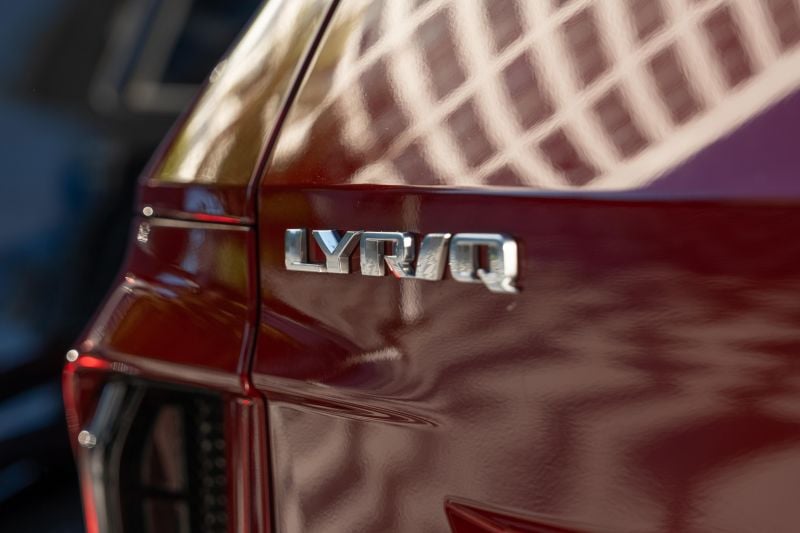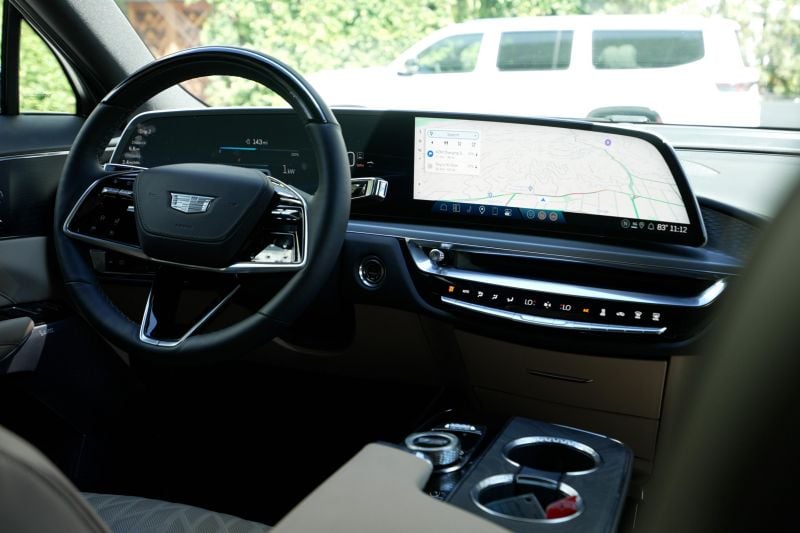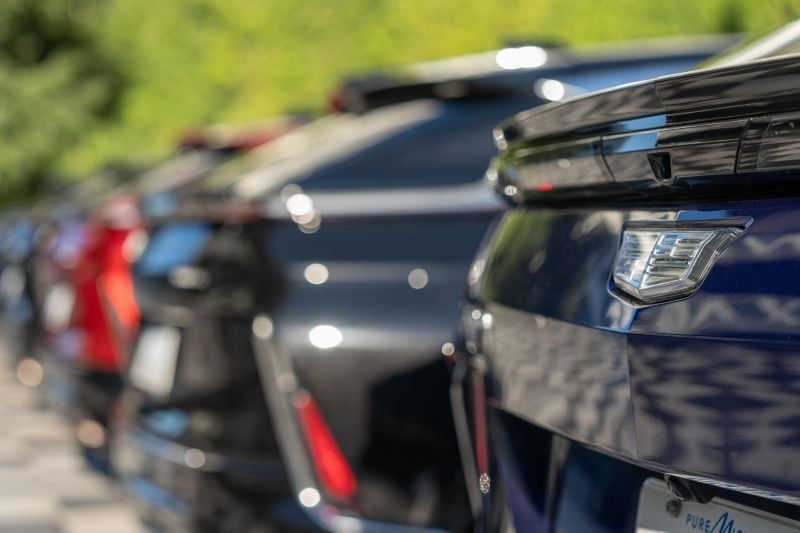There’s a flurry of carmakers coming to Australia’s crowded new car market, and almost all of them are Chinese brands with unfamiliar names and innocuously styled vehicles.
And then there’s Cadillac.
After coming maddeningly close to entering our market in 2009 – its launch was cancelled just weeks before its CTS sedan was set to go on sale – American luxury brand Cadillac is coming to Australia.
Orders are now open for its first (and thus far, only) model in Australia, the Lyriq electric SUV. It’ll be sold both online and through a limited network of Experience Centres: one in Sydney, and one in Melbourne.
It may ride on a dedicated electric vehicle (EV) platform, but it features a long bonnet and crisply tailored lines – after all, parent company General Motors said it wouldn’t make its EVs look like “lozenges”, unlike some rivals…
Magalie Debellis was responsible for the design of the Lyriq, Cadillac’s first EV, as well as the ultra-luxury flagship Celestiq which we won’t get here. While Cadillac hasn’t confirmed what’ll follow the Lyriq here, we’d put money on an expanded range of electric SUVs.
US deliveries of the Lyriq actually began in mid-2022, but Australian customer orders aren’t expected to commence until late 2024 or early 2025.
We’ve yet to test it in Australia, however parent company General Motors flew us to California to get behind the wheel of one.
Not only were the examples we drove left-hand drive, they were also US-spec, model year 2024 vehicles.
Our Lyriqs will roll out of the same Spring Hill, Tennessee plant in right-hand drive.
Model year 2025 brings minor changes like the introduction of front passenger-seat memory and more colours for the ambient lighting.
US-market dual-motor all-wheel drive models also get slightly more power (385kW vs. 373kW), but this upgrade hasn’t been confirmed for Australia.

How much does the Cadillac Lyriq cost?
Two versions of the Lyriq will be offered in Australia from launch – the Luxury, and the Sport.
| Model | Price before on-road costs |
|---|---|
| 2025 Cadillac Lyriq Luxury | $117,000 |
| 2025 Cadillac Lyriq Sport | $119,000 |
The Lyriq undercuts the BMW iX, Audi Q8 e-tron and Mercedes-Benz EQE SUV, all of which start at just over $130,000 before on-road costs.
To see how the Cadillac Lyriq lines up against the competition, check out our comparison tool.
What is the Cadillac Lyriq like on the inside?
The Lyriq has a very attractive interior, with elegant details, attractive colour palettes, and slick tech integration.
Cadillac has nailed the design, and there’s nothing in here that looks like it’s come from a Chevrolet – we just wish build quality was better.
We tested 2024 models intended for US customers and the vehicle has been in production for two years, so it’s not like we were driving pre-production examples.
Yet, the panel gaps were a bit too large around the centre stack, where there’s both a sliding drawer and something that looks like another compartment but it doesn’t open. One piece of plastic down here also had a bowed look.
While the sliding drawer operated smoothly – though couldn’t accommodate some larger smartphones – step outside and open the charge door and it nervously wobbles open.
Press the trim at the end of the centre console island and it creaks, the centre console bin lid wobbles just a tad, and the sides of the centre console and the lower half of the doors are finished in hard plastic. We’ve made similar complaints about the EQE SUV, but we’d still like to see better.
And we know Cadillac can do better – I drove a final-generation CTS which featured soft-touch surfaces everywhere, and a feeling of being hewn from granite.
The Lyriq’s interior is nicer than other Cadillac models bar perhaps the Escalade, but it’s not at the same level as the best of the Germans.
Fortunately, we didn’t experience any rattles or squeaks during our drive of the Lyriq.
The hard plastic stands in contrast with the elements where GM has clearly spent the money to differentiate this from a humble Chevy, like the tactile metallic switchgear for the climate control, the lovely open-pore wood trim and the metal twist knobs for the air vents.
There’s also a knurled metal dial for the infotainment, which has a nice heft to it but doesn’t feel as substantial when you press down on it. The shifter and indicator stalks have a nicely damped operation, and unlike an EQE SUV they won’t be easily mistaken for each other.
There’s a lovely brushed metal trim piece at the base of the centre stack, while the centre console shelf has an unusual leather-look floor finished in either blue, maroon or grey depending on the interior colourway.
There looks to be two different types of metallic trim used in the interior, but it doesn’t detract from the upscale ambience, while piano black trim is kept to a minimum.
Soft-touch trim has also been used across most of the dashboard and door uppers. There’s an available Nappa leather package, while the different colourways are all very attractive – we particularly like the subtle, dark green hues of the Juniper option.
The Lyriq’s curved screen actually incorporates three separate screens: a small touch panel to the left (or on Australian-spec cars, the right) of the steering wheel; a digital instrument cluster; and an infotainment touchscreen.
The infotainment system has a logical menu structure, attractive graphics, and quick response times. There are also handy shortcuts, including an anchored menu bar at the bottom of the screen that you can add apps to.
You can display Google Maps on both the instrument cluster and on the touchscreen, though it ends up being two discrete displays instead of extending across both like in, say, Genesis models with their new 27-inch OLED display.
The Google Maps integration means you can see an estimated charge percentage at your set destination, which is handy.
In some 2024 lunacy, the Lyriq’s glove compartment can be opened only via the touchscreen. That makes it secure, yes, but it also makes it a lot less convenient to access as doing so requires at least two button presses.
General Motors and Nissan were the first carmakers to introduce a head-up display, all the way back in 1988. And to this day, GM still offers a HUD on various vehicles, so why does the Lyriq lack one?
While we’re talking missing tech, we appreciate the inclusion of a massaging function for the Lyriq’s front seats but it has only one mode (a Nissan Qashqai has three) if with multiple levels of intensity.
The massaging seats at the German brands have a much more comprehensive array of modes. The seats are at least comfortable and supportive, and feature both heating and ventilation.
The dash feels low, and visibility out the front is great. Out the back, it’s compromised because of the sharply raked tailgate window. The inclusion of a digital rear-view mirror does aid visibility, however.
Step into the back and you’ll find plenty of space. There’s a comfortable bench, while the floor is flat.
The centre console does jut into the centre-seat occupant’s space somewhat, but there’s still ample room back here. Amenities include a pair of of USB-C outlets, a power outlet, and controls for the third climate zone.
The panoramic sunroof lets in a lot of light, but not much in the way of glare. We kept the shade open even in classically sunny California weather.
The boot has an ample 793L behind the rear seats. The rakish tailgate eats into space somewhat, but there’s still plenty of room. There are also controls back here to drop the rear seats.
| Dimensions | Cadillac Lyriq |
|---|---|
| Length | 5005mm |
| Width | 2207mm (incl. mirrors) |
| Height | 1623mm |
| Wheelbase | 3094mm |
| Cargo volume | 793L (behind rear seats) 1722L (with rear seats folded) |
To see how the Cadillac Lyriq lines up against the competition, check out our comparison tool.
What’s under the bonnet?
Cadillac puts a 600E4 badge on the tailgate of the Lyriq to signify it features the dual-motor all-wheel drive powertrain; a single-motor rear-wheel drive configuration is also available in the US but hasn’t been confirmed for Australia.
| Specifications | Cadillac Lyriq |
|---|---|
| Drivetrain | Dual-motor electric |
| Battery | 102kWh |
| Power | 373kW |
| Torque | 610Nm |
| 0-100km/h time | 5.3 seconds (claimed) |
| Driven wheels | All-wheel drive |
| Weight | 2774kg (kerb) |
| Claimed range | 530km (WLTP) |
| Energy consumption (claimed) | 22.5kWh/100km (WLTP) |
| Max AC charge rate | 22kW |
| Max DC charge rate | 190kW |
The use of ‘600’ doesn’t denote power output, but rather torque… in Newton metres, which the US market doesn’t use. Umm, okay. It’s arguably even stranger than Audi’s 50/55/etc naming convention.
Cadillac has yet to reveal a high-performance V version of the Lyriq, but spy shots have suggested such a vehicle is coming. Cadillac claims a DC fast charge will add 128km of range in 10 minutes.
To see how the Cadillac Lyriq lines up against the competition, check out our comparison tool.
How does the Cadillac Lyriq drive?
First, a few caveats – as these were US-market 2024 Lyriqs, they weren’t entirely representative of what we’ll get in Australia.
Beyond the steering wheel being on the ‘wrong’ side, the steering tune is different in US-market models. Cadillac is also deploying a different suspension tune for each wheel combination.
Australia is getting the same suspension tune as Europe, and the same standard 21-inch alloy wheels instead of the 20- and 22-inch options offered in the US.
The Lyriq’s lead development engineer says the Australian-market model will have a more dynamic feel. Translation: a little less float.
Not that the US-market model is some old Coupe de Ville. It proved comfortable over some shockingly battered Los Angeles streets, and though it took a moment to settle over some undulations it never felt ponderous.
The Lyriq eats up choppy road surfaces and bedraggled concrete freeways, with exceptionally comfortable ride quality in traditional Cadillac fashion.
There’s no air suspension, and you won’t find Cadillac’s Magnetic Ride Control with its magnetorheological dampers. There’s actually no adaptive system at all.
All Lyriqs, regardless of market, come with five-link front and rear suspension with what Cadillac calls Passive Plus dampers. These are frequency-dependent, and Cadillac claims they can differentiate between smaller impacts and larger swells on the road surface and react accordingly.
The cushy ride might suggest the Lyriq feels like a boat to drive, but fortunately it doesn’t. Body roll is well-controlled, while the Lyriq boasts a near 50/50 weight distribution.
On one unexpectedly tight corner I was impressed with how the Lyriq reacted to a sudden change in direction. We wouldn’t call the Lyriq sporty, but it feels nicely balanced.
The steering is well-weighted, and you can toggle between Tour and Sport modes. Even in the latter, it doesn’t feel too heavy around town, but it isn’t feather-light either. Cadillac has struck a good balance, but again you’re not going to have the same level of feel as one of its Blackwing cars.
Cadillac says the steering tune that’ll be used in Australia has been tuned to be a little bit more reactive, with more about-centre effort in Sport mode.
You can tailor a custom drive mode, with different settings for steering, accelerator pedal feel, brake pedal feel and propulsion sound. Disappointingly, changing drive modes can only be done via the touchscreen, and there’s no simple switch or voice prompt you can use.
There’s a very subtle propulsion sound, while the cabin is impressively quiet even at highway speeds and over rougher surfaces.
The Lyriq’s power is also doled out in a way that feels befitting of a luxury SUV. Even in Sport mode the Lyriq doesn’t jolt you back in your seat.
“There are multiple different schools of thought with regards to accelerator pedal tuning,” Kevin Cansiani, lead development engineer for the Lyriq, told CarExpert.
“Our ultimate goal was to make a customer that’s coming out of an ICE vehicle be very comfortable with getting into this vehicle, that they didn’t feel scared to press the accelerator pedal because they didn’t know it was going to be extremely jerky.”
Limiting jerk – an actual term used by GM engineers – was therefore a priority.
Cadillac says the Lyriq’s pAWD permanent dual-motor all-wheel drive system sees both electric motors used for power – however, the front motor will deactivate to maximise range. This system is also used in the high-performance Chevrolet Blazer EV SS.
In other products like the Cadillac Optiq, GM uses what it calls eAWD, where the second electric motor only kicks in when you lose grip.
The company says the pAWD system sees the torque split vary based on the drive mode and your driving behaviour.
GM uses the Ultium name a lot for its latest EVs, but that doesn’t refer to a specific platform. Instead, it refers to the software, the batteries and other high-voltage components, as well as the electric motors and the DC-AC inverters that run them.
The Lyriq shares many of these components with other Ultium-branded GM EVs, but there are some key differences under the skin.
Platform and component sharing is nothing new in the car industry, and Cadillac says the Lyriq has a different feel from other GM EVs.
For example, compared to the similarly sized Blazer EV, the Lyriq gets different tuning for components like the steering, as well as more sound deadening for a quieter cabin.
It also gets active noise cancellation, though Mr Cansiani said you could pull the fuse for this feature and it’d still be a quieter car.
We didn’t get to drive this back-to-back with any other GM products – or any rival EVs, for that matter – but suffice it to say the Lyriq has an appropriately luxurious, comfortable feel.
There’s a one-pedal drive mode that’s easily activated via the push of a button anchored to the bottom of the infotainment touchscreen. The one-pedal drive mode offers both normal and high settings.
Not only that, but there’s an intriguing feature called Regen on Demand.
There’s just one paddle shifter, and pulling it increases the level of regeneration. Rather than flipping between differing modes of regeneration, however, squeezing it instantaneously slows the vehicle.
It’s a bit like a brake pedal you operate with your finger, and while it sounds a bit unusual or even gimmicky at first, it’s surprisingly intuitive to use.
As mentioned, there’s disappointingly no head-up display. What looks like a cutout for one is actually just for the forward collision warning lights.
The suite of active safety technology works well, with the lane-keep assist proving capable yet not too intrusive. We also appreciate how the driver’s seat vibrates when these systems detect an imminent collision.
We had the opportunity to try out Super Cruise, GM’s Level 2+ autonomous driving technology that supports hands-free driving on over a million kilometres’ worth of roads in North America.
This feature has yet to be confirmed for Australia due to regulations, which is a shame as it works remarkably well on designated Californian highways.
When the black panel on the top of the steering wheel is illuminated with a green light, you can take your hands off the wheel and let the Lyriq drive for you. The wheel light will change colour when you need to take control.
It’s also clever enough to automatically change lanes if it detects the vehicle in front of you is going below your set speed.
Other clever technology includes automatic battery pre-conditioning when you’ve selected a destination using the embedded Google Maps. When the car detects you’re getting closer to a charging stop, it’ll start getting the battery to the optimal temperature for charging.
What do you get?
Two grades will be available in Australia from launch – the Lyriq Luxury and the Lyriq Sport.
Lyriq Luxury standard equipment:
- Semi-automatic parking assist
- Heated, power-folding exterior mirrors with puddle lights
- Panoramic sunroof
- Hands-free power tailgate
- 33-inch display
- Apple CarPlay and Android Auto
- Satellite navigation
- Active noise cancellation
- AKG Studio 19-speaker audio (incl. front headrest speakers)
- 126-colour ambient lighting
- Heated and ventilated front seats
- Power-adjustable front seats with power lumbar
- Heated outboard second-row seats
- Tri-zone climate control
Lyriq Sport adds:
- Dark grille finish
- Unique wheels
- Obsidian Chrome finishes and dark exterior accents
- Body-colour door handles
Nappa Leather Package ($TBC) adds:
- Nappa leather upholstery
- Nappa leather armrests
- Soft-wrapped upper instrument panel
- Dark Ash cluster decor trim with backlit door accents
*Available only with Oxford Stone or Juniper colourways
Is the Cadillac Lyriq safe?
The Lyriq has yet to be tested by ANCAP or Euro NCAP.
Standard safety equipment includes:
- Adaptive cruise control
- Autonomous emergency braking
- Intersection assist
- Blind-spot assist
- Front, front-side, front-knee and front curtain airbags
- Rear curtain airbags
- Surround-view camera
How much does the Cadillac Lyriq cost to run?
The Lyriq is backed by a five-year, unlimited-kilometre vehicle warranty, and an eight-year, 160,000km battery warranty. Cadillac is also offering five years of free servicing.
“Our Sydney Experience Centre, which will open soon, will be accompanied by a full service centre staffed by Cadillac trained EV specialists with the latest service and diagnostic equipment designed specifically for the Lyriq,” said a spokesperson for Cadillac Australia.
“As we launch our sales across the country, we intend to have Cadillac Certified Service centres in major cities.
“Our Cadillac team will work with each customer to determine the best option for them to take advantage of our Certified Service centres, whether that is to come to our service centre where we can provide options such as alternative transport, service while you wait, or customers can take advantage of our mobile servicing where available.”
CarExpert’s Take on the Cadillac Lyriq
Cadillac has wisely priced the Lyriq below its German rivals, because for all the recognition Australians have of the brand name, it doesn’t have a German badge on the grille – and that’s going to hold it back.
On a personal note, I’ll admit I’ve been fascinated by Cadillacs for years. But I’m hardly normal, and I wonder if the average Australian luxury car buyer is going to want to take the chance.
If Australians do know about the brand, I’d wager it’s only a vague recollection via pop culture of tail-finned de Villes from the 1950s or big V8-powered Escalades.
Do most Australians even know Cadillac has been making world-class sports sedans for 20 years, or that it offers electric SUVs like the Lyriq?
Cadillac needs to position itself as a challenger brand to cut through in our market, with sharp pricing and a desirable aftesales package.
Even then there’s no guarantee for instant success. Just look at Genesis, which has the best after-sales offering in the business and a range of genuinely good cars, but whose sales have hit a stumbling block and still aren’t anywhere near the dominant Germans.
Cadillac will have an even smaller retail network than Genesis has, and while we expect it will eventually grow, the reliance on company-run Experience Centres likely means a slow start as with its Korean rival. Good thing Cadillac has only spoken of “exclusive volumes” when it comes to sales targets.
Fortunately, Cadillac’s product itself stands up to scrutiny.
Sure, we’d like to see some tweaks to the interior to improve material quality and fitment. We also don’t know exactly how Australian-spec suspension and steering tunes will feel, and we’re disappointed in the lack of a head-up display or a decent massaging seat function.
What we found with the US-spec model, though, is a high level of refinement and a smooth, comfortable ride that doesn’t come at the expense of handling. The Lyriq has a distinctive, upscale look inside and out, a comfortable and spacious cabin, and a long list of standard equipment.
It’s a promising start for the American brand’s Australian launch.
Interested in buying a Cadillac Lyriq? Get in touch with one of CarExpert’s trusted dealers here
Click the images for the full gallery





